Chapter Six—
The Second Stage of Execution (c. 1375—77)
In contrast to the first stage of production of Charles V's Grandes Chroniques , which recorded French history from the fall of Troy to the death of Philip of Valois in 1350, the second portion describes only 25 years, from the accession of John the Good in 1350 to the ordinance of 1375, which established the age of majority for French kings at 14.
The quarter century recorded in this portion of the Grandes Chroniques was a time of marked change in the political fortunes of France.[1] Early in his reign John the Good, Charles V's father, was captured by the English at the Battle of Poitiers in 1356. Charles then began a gradual consolidation of power, first as lieutenant de roi and regent during his father's captivity and finally as king after John's death in England in 1364. The text reports a string of successes for the French house: the negotiation of a tentative peace with England; the suppression of rebellions fueled by Charles V's relative, Charles of Navarre, in Paris and Normandy; the homage of Charles of Navarre before Charles V; and, most important, the birth of a royal heir to Charles V and Jeanne of Bourbon.
A cycle of 26 miniatures faithfully mirrors the events recorded in the text. Most of these miniatures depict Charles's struggle with Étienne Marcel, the provost of Paris, or with Charles of Navarre, a claimant to the French throne. A second, smaller group of miniatures celebrates positive events of the reign by depicting important ceremonies. The large scale of these ceremonial pictures and their attention to details of costume and armorial bearings establish their importance. Their images evoke two broad themes: the idea of French supremacy over the English through the glorification of ideals of kingly behavior exemplified by John the Good, and the continuity of the Valois line in Charles's heir, Charles VI. In both cases the miniatures combine with their texts to focus on the past and future of the Valois line.
Kingship and Internal Politics
Textual changes in the first continuation of Charles V's Grandes Chroniques promote ideals of kingly behavior in the context of contemporary political rivalries, exaggerating English misconduct and minimizing French deficiencies. When Raoulet d'Orléans continued Henri de Trévou's text, he substituted four rewritten pages for the last few folios of the life of Philip of Valois and made editorial changes in the first part of the same gathering.[2] Almost all the leaves immediately preceding
the substitution are corrected more carefully than in the first portion of the book. In fact, three folios before the change of scribe, a sizable paragraph dealing with the abbey of Saint-Denis is crossed out emphatically and a red vacat (void) penned in its margins (fol. 383). This unflattering paragraph refers to Philip of Valois's request for the abbey's gold crucifix as a war subsidy despite a papal inscription on its base threatening excommunication of the person who dared remove it from the abbey.[3] This account of kingly greed, like the account of Hugh Capet's jealousy in the first portion of the chronicle, was probably deemed unsuitable in a royal commission.
A few folios later, in the substituted text, an elaborate description of the siege of Calais reveals a more extensive example of pro-French editing. Later versions of the Grandes Chroniques contain the text that probably originally existed in Charles's manuscript. They simply state that Philip of Valois arrived too late to help the residents of Calais, who surrendered because they had nothing to eat.[4] This book, however, stresses the "great care and diligence" with which Philip tried to help the city; the wickedness of the English king, who broke a treaty to continue the siege; and the suffering of the people of Calais, reduced to eating horses, cats, dogs, and rats, before their surrender.[5]
Like these texts, prominent images also promote French superiority over the English. They laud the kingly behavior of John the Good and denigrate the English. For example, one of the most striking miniatures in this portion of the Grandes Chroniques , a picture of the meeting and feast of the Order of the Star (Fig. 76), illustrates a chapter that describes the treachery of the English, who broke a treaty with the French to capture the city of Guines.[6] This picture commands the reader's attention by its position and scale; it follows the text that it illustrates, and it is one of only three miniatures in the whole manuscript that fill three-quarters of a page each.[7]
The rubric to this chapter suggests that the miniature of the Order of the Star is related to the text that precedes it. In Charles V's manuscript the traditional rubric for the third chapter of John the Good's life, "How the city and castle of Guines were captured by the English, the day that the king of France celebrated with the Order of the Star at Saint-Ouen," is expanded to include the phrase, "which feast is portrayed and illustrated below."[8]
The picture illustrates a discussion between the king and several members of the order on the occasion of a feast. Regarding this episode, the text simply states that John the Good founded the order in October 1351 and that the members wore stars on their hoods or mantles. The picture, on the other hand, includes more specific details of costume: white tunics, red mantles, pearl-studded fillets that the participants tied around their foreheads, and complicated stars.[9]
Because the order no longer existed in the 1370s, this image is an archaeological reconstruction. Both the royal accounts relating to the execution of elements of costume and John the Good's ordinance sent to a group of nobles and princes in 1351 to recruit members offer proof that the costumes included in the painting were authentic.[10] Thus, when this miniature was painted, more than 20 years after the event, the artist incorporated evidence derived either from an eyewitness account of the events or from court documents.[11]
Why lavish so much attention on a miniature that not only departs from traditional placement and scale but also addresses a subject of apparently little
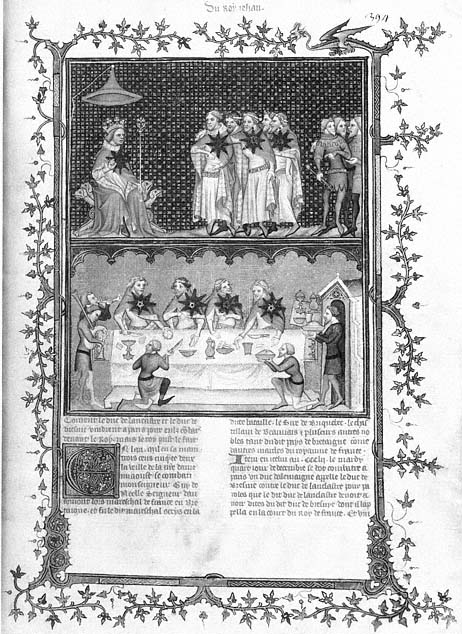
Figure 76
Order of the Star. Grandes Chroniques de France . Bibliothèque Nationale,
Ms. fr. 2813, fol. 394. Photograph: Bibliothèque Nationale, Paris.
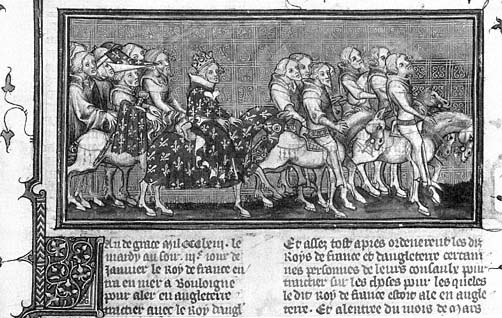
Figure 77
John the Good enters London. Grandes Chroniques de France . Bibliothèque Nationale, Ms. fr.
2813, fol. 438. Photograph: Bibliothèque Nationale, Paris.
significance to the text? The answer lies in the motivation for the founding of the order and in the contemporary perception of its goals. The full title of the order, Company of Knights of Our Lady of the Noble House at Saint-Ouen, gives a clue to its purpose.[12] To create a tighter bond between John and members of the nobility, the order intertwined the cult of the Virgin with a series of regulations that restricted the conditions under which a member could do battle. Ties like the one created by this order became increasingly necessary for the French as loyalties shifted during the Hundred Years' War.
Even more important to an understanding of this picture, however, is the relationship between the Order of the Star and the English Order of the Garter, founded by Edward III.[13] The rules and goals of these orders changed in response to each monarch's need to ensure the loyalty of his troops and, more important, in response to developments on the other side of the channel. Thus the Order of the Star, founded approximately three years after its English counterpart, was a rallying point for French chivalry—a political statement expressing clear opposition to the English and perhaps responding to the Order of the Garter.
The relationship between this miniature and its text confirms the political interpretation of the Order of the Star in France. While the text focuses on the neglect of a treaty by the English and their use of treachery to capture a city, the miniature presents a picture of the victorious French king united with his loyal knights, who stand in opposition to those who threaten the realm. Thus French virtue is contrasted with English decadence.
The only other two-column miniature featuring John the Good offers a more specific glorification of kingly behavior. John's royal entry into London in 1363 (Fig. 77) marked his willing return to captivity after Louis, duke of Anjou,
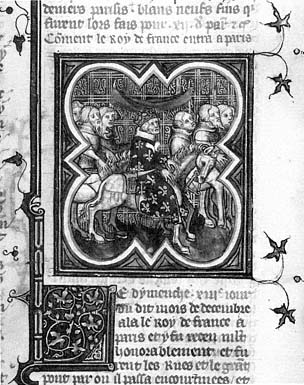
Figure 78
John the Good enters Paris. Grandes Chroniques de
France . Bibliothèque Nationale, Ms. fr. 2813, fol. 436v.
Photograph: Bibliothèque Nationale, Paris.
John's second son and one of the hostages who had taken the king's place in England in 1360, returned to France without permission. This breach of honor, coupled with France's difficulty in meeting ransom payments, broke the Treaty of Brétigny. For John the Good, the only honorable recourse was to return to London.[14] The scale of this miniature highlights the importance to Charles V of his father's honorable behavior. The miniature depicting John's royal entry into Paris when he was released in 1360 (Fig. 78) is of normal size. Only his voluntary return to captivity, a gesture lauded by the French, is shown in large scale.[15]
The Royal Succession
The continuity of the Valois line is the second theme addressed by the ceremonial images in Charles V's Grandes Chroniques . When seen together, miniatures showing the peers supporting the crown at the coronation of Jeanne de Bourbon and Charles V and the baptismal procession of Charles VI assert that the Valois line flourishes in the person of the young heir.
The scene that introduces the narrative of Charles V's life, a double miniature of the peers supporting the enthroned king and queen, is one of the most perplexing in this Grandes Chroniques de France (Plate 4). Historians and art
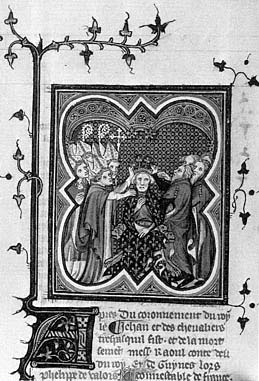
Figure 79
Coronation of John the Good. Grandes
Chroniques de France . Bibliothèque
Nationale, Ms. fr. 2813, fol. 393.
Photograph: Bibliothèque Nationale, Paris.
historians alike have dismissed it from serious consideration because it copies earlier images.[16] Paradoxically, it is precisely this dependence that makes the scene representing Charles's coronation special. Of the 175 pictures in this manuscript, it is one of only two derivative miniatures, a status that raises questions about its function in the Grandes Chroniques . Though derivative, it is not an exact copy of its model. Subtle changes in composition and heraldry, which alter the image to fit its new setting, can be explained by careful consideration of the specific context of Charles V's manuscript and the more generalized context of contemporary historical events.
The image was painted between 1375 and 1377 to decorate a continuation of the Grandes Chroniques , written at court, that ends in a chapter covering two events of 1375: the publication in the Parlement of Paris of the ordinance regulating the majority of the French kings and the making of a treaty with the English at Bruges.[17] Apparently the chronicle was thought complete at this time and was probably bound. This continuation provides the specific context for the miniature.
In the detail employed the portrayal of the ceremony in this miniature differs from depictions in the manuscript of the commencement of other kings' reigns. Compare, for example, the details of the illustration of John the Good's coronation (Fig. 79), painted in the same campaign as the double scene of Charles V
and Jeanne of Bourbon. In this image the fleur-de-lis identifies the coronation as French, but it is impossible to identify the king. In the double miniature the king and queen hold recognizable objects: Charles grasps a scepter representing Charlemagne enthroned, which was made for him and is still preserved in the Louvre, and Jeanne of Bourbon holds in her right hand the scepter of Dagobert, known from eighteenth-century drawings by Montfaucon.[18]
Scholars have explained the specificity of this picture by citing its models—images from Charles V's commemorative Coronation Book (Plates 5 and 6).[19] The Coronation Book , produced in 1365 under Charles V's direct supervision, was decorated by the same workshop that later painted the double picture in the Grandes Chroniques . Because it formed part of the royal library, the Coronation Book was an authoritative and convenient model for the images in the Grandes Chroniques . This relationship provides a plausible explanation for the compositional similarity of the images, but it makes their other differences even more problematic.
One puzzling difference is the moment chosen to illustrate the beginning of Charles V's reign. Instead of the moment of coronation, the picture in the Grandes Chroniques represents a portion of the ceremony that occurred after the coronation proper—a symbolic expression of support for the new king and queen by the clerical and lay peers. The text of the chronicle does not mention this occurrence. It states that the king and queen were crowned and lists some of the nobles in attendance.[20] Strictly speaking, the miniatures of the coronations of Charles V and Jeanne of Bourbon from the Coronation Book would have been more appropriate models if the only goal of this picture were the commemoration of the event recounted in the text.[21]
Another significant divergence from the Coronation Book is evident in the placement of the queen's picture next to the king's. As recorded in the Coronation Book , the ceremony of the queen's coronation was begun only after the king's was finished. The double miniature in the Grandes Chroniques thus juxtaposes two pictures that were separated by 11 folios and as many miniatures in the Coronation Book . This representation of parallel moments from the two ceremonies glosses over the temporal separation between them and, in the process, gives more prominence to the queen, presenting her on an almost equal footing with the king.
The heraldry of the double miniature in Charles V's chronicle is also subtly different from that of its models. In the Coronation Book's treatment of the king's coronation, one image (Plate 5) shows the king flanked by the count of Flanders, the duke of Bourbon, the count of Toulouse, the duke of Anjou, the archbishop of Reims, and the bishop of Beauvais. The corresponding miniature of the queen's coronation (Plate 6) shows the queen flanked by the count of Toulouse, the count of Étampes, the bishop of Beauvais, and the archbishop of Reims.[22]
The positions of three people changed when these scenes were copied into the Grandes Chroniques (Plate 4). In the scene showing the peers supporting the crown after the coronation of the queen, the duke of Burgundy replaced the count of Toulouse, and the duke of Bourbon replaced the count of Étampes.[23] In the scene with the king, the count of Étampes takes the position near the king that the duke of Bourbon held in the Coronation Book .
These careful heraldic changes do not increase the historical accuracy of the picture. Of the peers distinguished by heraldry in the miniatures, the Grandes Chroniques only mentions the presence of the archbishop of Reims; the bishop
of Beauvais; Louis, duke of Anjou; and Philip the Bold, duke of Burgundy at the ceremony.[24] Although not mentioned specifically in the text of the chronicle, the count of Étampes, the count of Flanders, and the duke of Bourbon were peers at the time of the coronation; they were listed as such in both Charles V's Coronation Book and the conflicting list of peers that appeared in the Traité du sacre , the commentary on the ceremony of coronation commissioned by Charles V from Jean Golein in 1374.[25]
Whether the counts of Flanders and Toulouse were really present at the coronation is not germane to this discussion, since the counts appear in both the Grandes Chroniques and the Coronation Book . More intriguing are the differences introduced in the Grandes Chroniques: the duke of Burgundy is brought into the scene of support for the queen, and the positions of the duke of Bourbon and the count of Étampes are changed to place the duke of Bourbon by the queen.
Because the dukes of Bourbon and Burgundy and the count of Étampes were present at the coronation, pictorial or written accounts of the ceremony cannot explain discrepancies between these pictures. In fact, the reason may have been Charles V's concerns for the education of his heir. Charles V's first child, who became Charles VI, was born in 1368 during the period between the execution of the Coronation Book and the Grandes Chroniques de France . The birth of a son, which had been eagerly anticipated for 18 years, ensured the continuity of the Valois line. To safeguard this continuity in the event of his death, Charles V promulgated three ordinances in 1374.[26] One concerned the age of majority. Published in the Parlement of Paris in 1375, it was the subject of the last chapter of Charles V's life in this copy of the Grandes Chroniques . It thus closed the reign that began with the scene of the peers' support. In many ways this ordinance marked a logical ending for this version of the chronicle, which was written and painted between 1375 and 1377, while Charles V was still king. Although it did not complete Charles V's life, it did provide a plan for a smooth transition to his son's government.
A second ordinance, which was not included in the chronicle, charged Jeanne of Bourbon with the education and upbringing of her children and provided her with two principal assistants: her brother-in-law, Philip the Bold, duke of Burgundy; and her brother, Louis, duke of Bourbon. The association of Philip and Louis with the queen in this special charge must have been reason enough to include them with her in this picture and could help to explain why the queen's picture was placed next to the king's—to demonstrate the provisions for legitimate government.
The decision to depict a moment of support rather than the moment of coronation may also reflect Charles V's concern with providing a smooth transition to the government of his heir. A contemporary text, the Traité du sacre by Jean Golein, provides insights into the significance of this ceremony.[27] Completed in the same year as the ordinance on government and contemporary with the painting of the miniature in the Grandes Chroniques , Golein's treatise glosses the events of the coronation with an explanation of their symbolic meaning. In his treatise Golein frequently stresses the peers' role in assisting in the just government of France as defenders of king and realm. According to Golein, "The peers surround the king to signify the forces who surround Solomon, all of them expert with the sword, skilled in battle, because if they [the peers] are not presently holding their swords, they are nearby to be taken when it is time to defend the king and realm."[28]
Perhaps dual images of baronial support were represented in the Grandes Chroniques to show that the peers were ready to defend their present king (Charles V) and to uphold the government of his descendants—a government in which the queen and the peers flanking her were supposed to play an important role.
On the most basic level, this picture is a special commemoration of Charles V's and Jeanne of Bourbon's coronations in 1364, deriving its iconography from the official commemorative manuscript of the coronation. However, this commemorative function may be less important than a second function: to introduce Charles V's reign while simultaneously alluding to its conclusion—to the provisions for government under the young dauphin and the peers' duty to protect and defend the realm and their king, no matter what his age.
Support for this interpretation is found in an analysis of a miniature representing the baptismal procession of the dauphin (Fig. 80), the only other large ceremonial picture from this version of Charles's life.[29] The theme of dynastic continuity to which the miniature of baronial support only alludes is amplified in the representation of the procession that took place in 1368 when Charles's firstborn son was christened. This illustration reflects its narrative, which describes the order of the large procession and lists the distinguished guests in attendance.[30] Of particular interest is the description of Queen Jeanne of Evreux, widow of Charles IV, carrying the dauphin between his two godfathers, Charles of Montmorency and Charles of Dammartin, in the procession to the church. To increase compositional clarity in the miniature, the queen is placed slightly behind the godfathers, in a position that further emphasizes her important role in the event. Prior to the
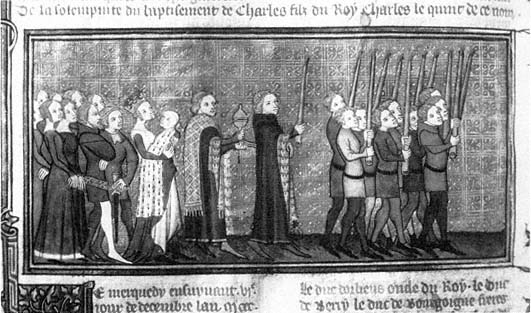
Figure 80
Baptismal procession of Charles VI. Grandes Chroniques de France . Bibliothèque Nationale, Ms. fr.
2813, fol. 446v. Photograph: Bibliothèque Nationale, Paris.
sixteenth century, when descriptions of baptisms of dauphins began to specify that the godfather carried the godchild, there seems to have been no fixed protocol governing this aspect of the ceremony.[31] Therefore, Charles V's choice of Jeanne of Evreux, the surviving wife of the last Capetian king and a constant negotiator for peace between Charles V and Charles of Navarre, is particularly significant.[32] Her role in carrying the Valois heir must have been seen at the time as an affirmation of the continuity between Capetian and Valois—of the sanction of the Capetian kings for their Valois successors.
A contradiction between the accounts of the Grandes Chroniques and the continuations of Guillaume de Nangis's Chronique abrégée raises a question as to Jeanne of Evreux's actual role in the baptism. Dating from the 1380s, the continuations of the Chronique abrégée include a description of the baptism identical to that of the Grandes Chroniques except that Jeanne of Evreux's part in the ceremony is suppressed, and Charles of Montmorency carries the infant, accompanied by Charles of Dammartin.[33] This deviation is notable in a text that copies Charles V's Grandes Chroniques so carefully that it transcribes one of the marginal notes unique to this royal manuscript.[34] The exact significance of this break from the official account preserved in Charles's manuscript remains undetermined. It may be that Jeanne of Evreux's death in 1371, which ended her negotiations between the houses of France and Navarre, also lessened her utility as a symbol of Capetian support for the Valois line. A second possibility is that the compiler of the Chronique abrégée noted an inconsistency in the Grandes Chroniques , which he rectified. The Grandes Chroniques describes Jeanne of Evreux carrying the dauphin but also includes her among the distinguished guests following behind in the procession, "la royne Jeanne, la Duchesse d'Orliens sa fille."[35]
The miniatures that punctuate Raoulet d'Orléans's first continuation of the Grandes Chroniques function differently from those in the earlier portion of the manuscript. Illustrations to the life of John the Good and the first part of the life of Charles V document Charles's gradual consolidation of power. At the same time, a small group of texts and images of ceremony that are unique to this manuscript addresses different issues. Their assertion of French supremacy through illustrations of John the Good's kingship and through the emphasis on the Valois succession in images of Charles VI manifests underlying political and dynastic themes that reach fuller expression in the third part of the manuscript.